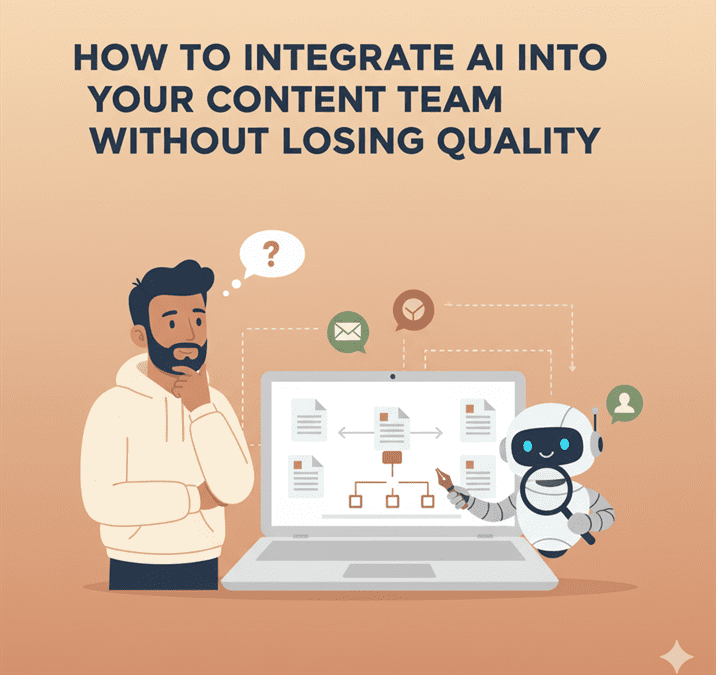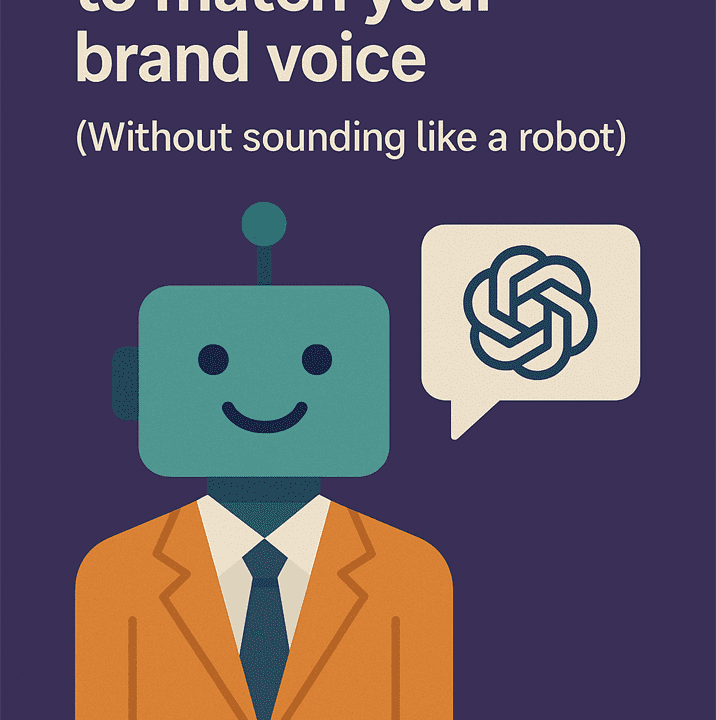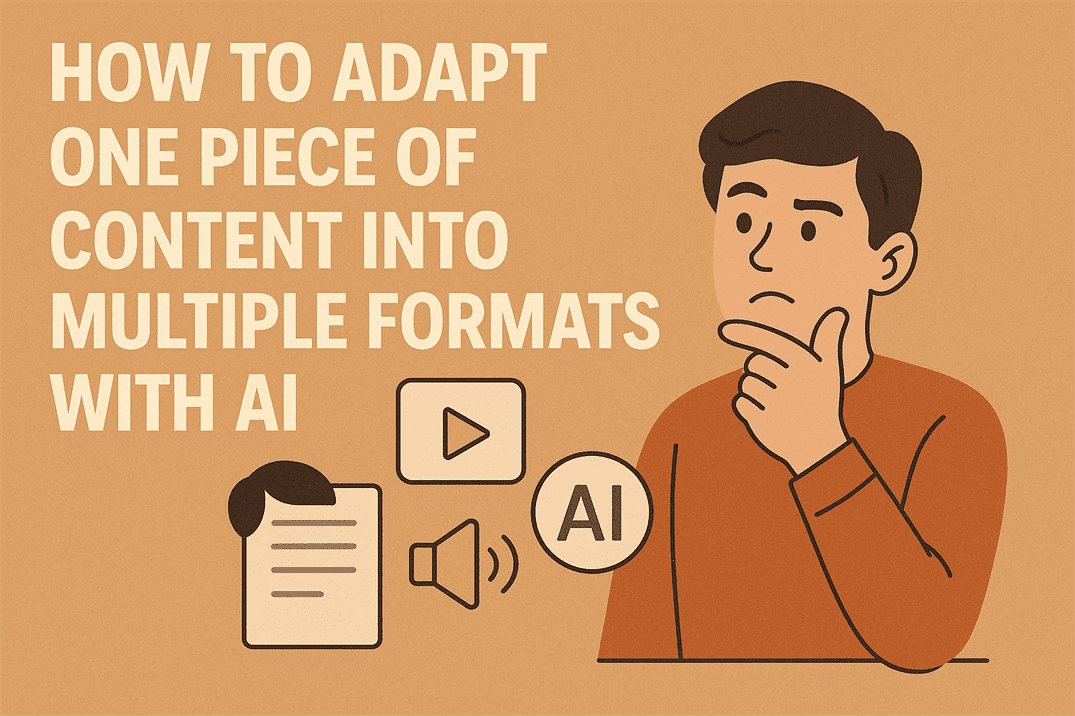How to integrate AI into your content team without losing quality

Let’s get one thing straight, AI isn’t here to steal your job. It’s here to become that slightly overeager new hire who turns up on time, works at the speed of light and occasionally forgets that Paris isn’t a country.
The trick isn’t whether to use AI, it’s how to make it part of your team without sacrificing the very thing that makes your content worth reading.
Think of AI as the extra set of hands you never had budget for.
Except these hands sometimes produce sentences that sound like they were written by an alien copywriter trying to blend in at a corporate mixer.
Your job is to keep it on track, give it rules and to remember you’re still the editor-in-chief of this circus.
Identifying tasks that benefit from ai support
AI isn’t good at everything (yet). But it shines in a few areas where humans get bored, distracted, or wander off to make another cup of tea.
Great tasks for AI:
- Idea generation: Headlines, outlines, angles. (The brainstorm that never tires, though sometimes it suggests nonsense like “How Hedgehogs Can Save Your Marketing Funnel.”)
- First drafts of repetitive copy: Product descriptions, meta tags, FAQs.
- Summaries: Turning long research papers into digestible notes.
- Format shifting: Blog → email → social snippets.
Tasks to keep human:
- Fact-checking, nuance, judgement calls, humour (unless you like jokes that read like they were written by a polite robot uncle).
- Storytelling, brand positioning, and anything where the stakes are higher than “meh, we’ll edit it later.”
Setting AI usage guidelines (tone, fact-checking, ethics)
If you unleash AI without rules, you’ll wake up one morning to find your blog reads like a Wikipedia page that’s had too much coffee.
Set boundaries early:
- Tone: Specify the voice (casual, professional, sarcastic-but-kind). Otherwise, it defaults to “overly polite academic trying too hard.”
- Fact-checking: Make it clear that AI drafts, humans verify. No exceptions. (Otherwise, you’ll end up citing sources that don’t exist. Awkward.)
- Ethics: No plagiarism, no passing off AI text as purely human, no making up quotes from celebrities. If the AI says Steve Jobs endorsed your SaaS tool in 2023, you’ve got a problem.
Training team members to prompt effectively
Prompting is the new typing. If your team doesn’t know how to ask AI the right questions, they’ll get answers as useful as a chocolate teapot.
Teach them the basics:
- Be specific: “Write a 500-word blog post about SEO tips for beginners in a friendly, accessible tone.”
- Set boundaries: “Give me 5 ideas, not 50.”
- Add examples: “Match the tone of this sample paragraph.”
Bonus rule: Encourage experimentation. Prompting is part science, part art, part witchcraft.
Creating ai-assisted editorial workflows
The sweet spot is where AI does the heavy lifting and humans come in with the polish.
Think of it like cooking with a sous chef. They chop the onions, you make sure nobody cries.
Sample workflow:
- AI drafts the outline.
- Human approves structure.
- AI generates first draft.
- Human edits for accuracy, tone and brand fit.
- AI can reformat text into social snippets, FAQs, or meta descriptions.
- Human gives final approval before anything goes live.
Maintaining brand voice across human and ai output
One danger with AI is that it sometimes forgets who it’s writing for. One day you’re quirky and conversational, the next you sound like a tax accountant.
To fix this:
- Create a brand voice guide (with tone, examples, dos/don’ts).
- Feed the guide into your prompts or the Personalize section.
- Have humans check every piece against it.
Brand voice is like seasoning. AI will throw salt everywhere if you don’t tell it where the shaker lives.
Monitoring and reviewing AI-generated work
“Trust but verify” isn’t just a Cold War motto, it’s your AI workflow mantra.
Keep a simple checklist:
- Is it accurate?
- Does it sound like us?
- Is it useful, or just filler words strung together like an over-enthusiastic fridge magnet poem?
Schedule regular reviews of AI’s output. Use analytics too. If AI-assisted posts are performing worse than human-only ones, adjust your approach.
Conclusion: AI as an extension of your editorial standards
AI doesn’t replace editors. It amplifies them.
It’s the exoskeleton to your creative muscles, the caffeine to your late-night deadline, the extra team member who never sleeps but occasionally suggests you “synergize cross-platform paradigms.”
With guidelines, training, and human oversight, AI becomes an extension of your editorial standards rather than a threat to them.
The goal isn’t to churn out more stuff. It’s to maintain quality, protect your brand, and free up your team’s best energy for the work only humans can do, adding wit, empathy, and that weird anecdote about your cat that somehow makes the piece unforgettable.
If you need help setting up AI in your content team or with adding the human element to your content, I’m happy to help.



